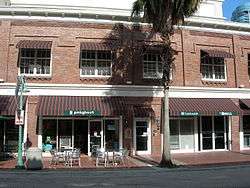Bryan Building
The Bryan Building, which has also been known as the Shepherd Building and as the DeSoto Hotel, is a historic site in Fort Lauderdale, Florida. It is located at 220-230 Brickell Avenue. In 1997 it was added to the U.S. National Register of Historic Places.[1]
Bryan Building | |
 | |
  | |
| Location | 220-230 Brickell Ave., Fort Lauderdale, Florida |
|---|---|
| Coordinates | 26°07′10.84″N 80°08′39.33″W |
| Area | less than 1 acre (0.40 ha) |
| Built | 1913-14 |
| Architectural style | Masonry vernacular |
| NRHP reference No. | 97001282[1] |
| Added to NRHP | 30 October 1997 |
Building
It is a two-story masonry vernacular building. It has brick detailing and brick columns in its front facade.[2] The brick facade is unusual in south Florida, most buildings there are constructed of poured concrete or hollow clay tile.[2] It is a rectangular building that faces west with five storefronts, separated by brick pilasters that have large plate glass windows.[2] The upper floor has eight windows with brick framing resembling a simplified Greek key design.[2] The first and second floor are divided by a cast stucco course with a projecting pediment, below which is an arched door.[2] The south side of the building has four ground floor windows and two doorways the back one leading to a stairway to the second floor and the one on the southwest corner served as the entrance to offices.[2] On this side the first and second floors are divided by a single band of raised brick. The upper story windows are detailed similarly to those on the west side.[2] Primary access to the upper floors has been via a stairway inside the west-facing arched doorway.[2] The upstairs floor and ceiling were constructed of Dade County Pine.[3]
History
It was built by Thomas Bryan after the 1912 fire in downtown Fort Lauderdale and it is the least altered building of its era in the area.[2] Thomas was the son of Nathaniel Bryan who supervised construction of the extension of Henry Flagler's Florida East Coast Railway from West Palm Beach to Miami.[2] He was active in the development and city affairs of Fort Lauderdale and is his activities helped lead to the establishment of Broward County.[2] The area the building is located in was Fort Lauderdale's original downtown commercial center.[2]
Usage
The Post Office was located in the building from 1914 to 1925, about this time The Fort Lauderdale Bank also occupied the ground floor.[2] From the 1920s to the early 1990s the second floor was a hotel or rooming house.[2] Hotels in the building included the Hotel DeSoto (1919 to at least 1927), the Lee Hotel (1936-1938), the Hotel Boriss (1940–1946) and the Dorsey Hotel (1950–1965) a men-only hotel with a cowboy motif.[2] The law offices of attorney and City Judge Ennis Shepherd occupied a portion of the ground floor from 1947 to the early 1900s.[2][4][note 1] Read's Dry Goods where locals often purchased materials to make clothes, other dry goods merchants, beef purveyors, real estate offices and insurance agencies were among other tenants.[2] Fort Lauderdale's downtown business district declined in the 1960s due to suburbanization.[2] The building got a historically appropriate renovation about 1998.[2][3] The renovation and application for designation as historic was part of a deal a local developer made allowing the demolition of another old local building, the Oliver Building.[6]
Notes
- A newspaper article gives the dates that Ennis Shepherd had an office in the building as 1944 to 1996.[5]
References
- "National Register Information System – Bryan Building (#97001282)". National Register of Historic Places. National Park Service. 9 July 2010.
- Dav, Jane; Krassv, Susan; Shiver, Carl (September 1997). "National Register of Historic Places Inventory/Nomination: Bryan Building / Shepherd Building / DeSoto Hotel". National Park Service. Retrieved 29 October 2017. With five photos from 1996.
- Altaner, David (30 January 2000). "Steve Halmos". Sun-Sentinel. Broward, FL. Archived from the original on 7 March 2014.
- Cunningham, Denyse (2003). "Broward County sites on the National Register of Historic Places". Broward Legacy. 24 (1). Broward County Historical Commission. p. 17. Retrieved 28 November 2018.
- Brown, Susan (2 May 1997). "Restoring the past new owner spends $1 million to renovate downtown Fort Lauderdale building to its 1913 appearance". Sun-Sentinel. p. 1D. ProQuest 388372322.
- Benedick, Robin (29 October 1995). "Lauderdale's past in jeopardy redevelopment may destroy many historic downtown buildings". Sun-Sentinel. p. 1B. ProQuest 388696514.
Further reading
- Matos, Rafael (19 June 1994). "Remembering Brickell downtown street used to be the center of business activity". City Plus. Sun-Sentinel. p. 8.
- Feinstein-Bartl, Beth; Cherry, Alan (15 October 1997). "Early settlers honored celebrate Pioneer Days". Sun-Sentinel. p. 3. ProQuest 388298406.
External links
- Bryan Building at the Wayback Machine (archived 10 March 2007) Florida Division of Historical Resources

